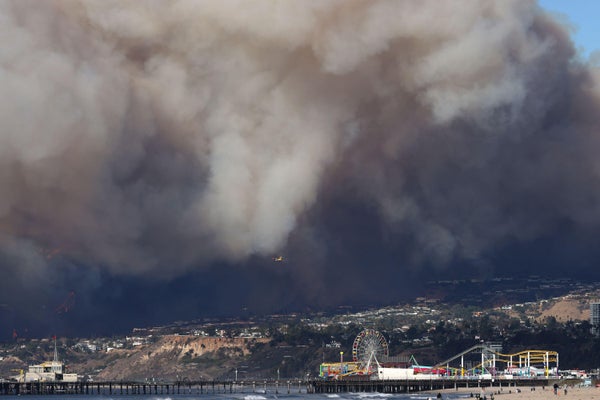Explosive Palisades Fire Fueled by Santa Ana Winds
January 7, 20252 min readFerocious Santa Ana Winds Fuel Explosive Palisades FireThe nature of the Santa Ana winds makes them perfectly suited to spreading flames. The destructive Palisades Fire is the latest exampleBy Andrea Thompson edited by Dean VisserThe Palisades Fire on January 7, 2025. ZUMA Press, Inc. / Alamy Stock PhotoAnother explosive wildfire has erupted in Californiaigniting buildings and sending residents fleeing. Wildly driven by the regions notorious Santa Ana winds, the Palisades Fire began at 10:30 A.M. local time near Los Angeless Pacific Palisades neighborhood, much of which is under evacuation orders.Forecasters had warned that the risk of fire was extremely high this week, reaching particularly dangerous situation status as the ferocious winds combined with tinder-dry vegetation after a lack of rain during the beginning of what would usually be the wet season.Gusts around the Palisades Fire have been measured in the range of 40 to 50 miles per hour, climate scientist Daniel Swain said during one of his regular virtual climate and weather office hours, hosted on YouTube. Right now the winds are not extremely high, but again, theyre high enough, said Swain, with the University of California Agriculture and Natural Resources. Gusts are expected to reach 70 to 80 mph as the winds peak Tuesday night into Wednesday, and some places could see gusts as high as 100 mph.On supporting science journalismIf you're enjoying this article, consider supporting our award-winning journalism by subscribing. By purchasing a subscription you are helping to ensure the future of impactful stories about the discoveries and ideas shaping our world today.The Santa Ana winds commonly propel fast-moving, damaging fires in this area; their characteristic dryness and speed can rapidly fan and spread flames. These winds are a result of local geography and a particular meteorological setup in which a high-pressure system sits over the Great Basin in the interior of the U.S. West and a low-pressure system hangs over California or offshore. Winds want to move from high to low pressure, and as they do so in this area, they travel downslope from the relatively high deserts. This descent compresses the air, warming it up and drying it out. (Such downslope winds, which happen in other locations around the world, are scientifically termed katabatic winds.)The Santa Ana winds are additionally funneled through narrow mountain canyons, which causes them to speed up. The hot, dry and fast nature of these winds makes them perfectly suited to spreading flames from any spark that ignites.Experts are watching for other possible blazes, and they will also see how the Palisades Fire spreads as the winds increase overnight. Everything is going to get worse before it gets better, Swain said in his video.


